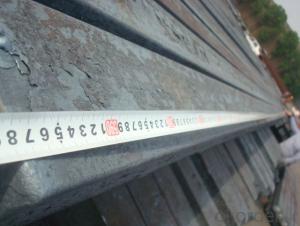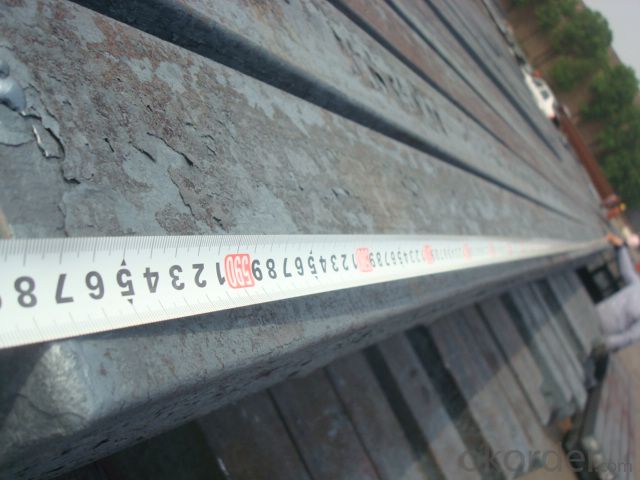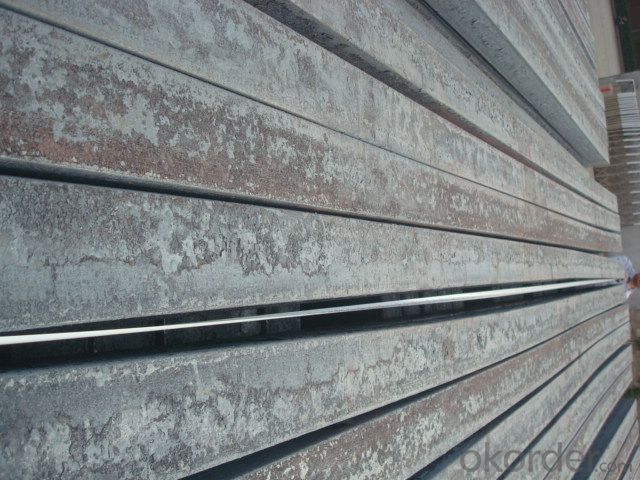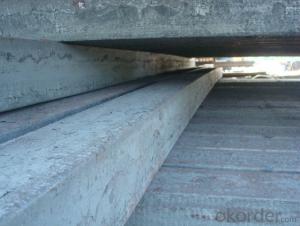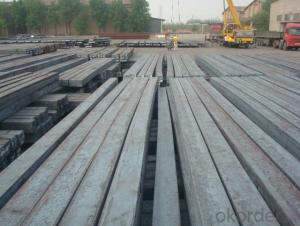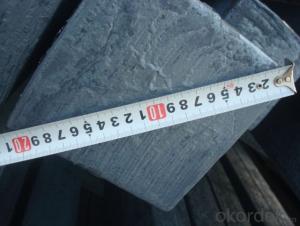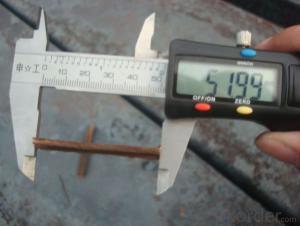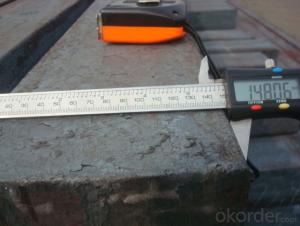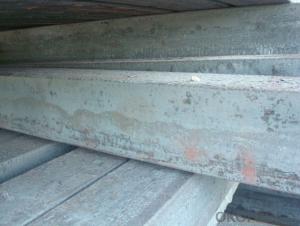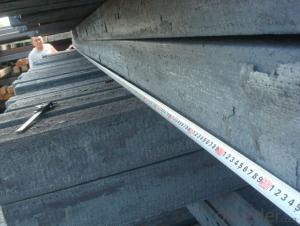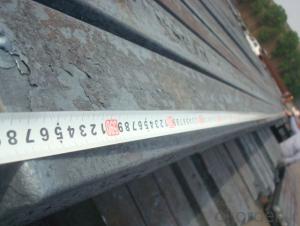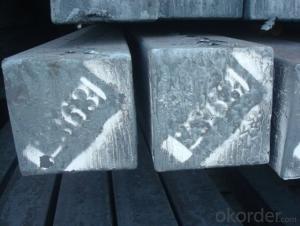Steel Billets/Blooms by Continue Casting Blast Furnace
- Loading Port:
- Tianjin
- Payment Terms:
- TT OR LC
- Min Order Qty:
- 1000 m.t.
- Supply Capability:
- 10000 m.t./month
OKorder Service Pledge
OKorder Financial Service
You Might Also Like
Steel Billets/Blooms by Continue Casting Blast Furnace
1.Structure of Steel Billets/Blooms by Continue Casting Blast Furnace
Continue Casting Steel Billet Manufactured By Blasting Furnace is the raw material of all kinds of steel mill. Billet section of square, round, flat, rectangular and abnormity, etc Several, mainly related to shape of rolled products. Simple rolled section steel, choose cross section of square billet or rectangular billet. rolling The sector products such as flat steel, Angle steel, select the rectangular billet or slab. Had better profiled billet when production beams, channels, and in rolling process Lines and improve the yield. The raw material of round billet is the production of seamless tube.
2.Main Features of Steel Billets/Blooms by Continue Casting Blast Furnace.
Continue Casting Steel Billet Manufactured By Blasting Furnace section size should meet the requirements of rolling deformation and finished product quality, but also roll strength and biting condition of restrictions. General steel Billet section height H. And the roll diameter D The ratio of the ( namely H/D) Should be less than or equal to zero 0.5 . Length of steel billet by finishing temperature, Rolling time and the length of the product Or times ruler. When heated too long accident prone to bump the furnace wall of steel, too short, furnace bottom utilization rate is not high, influence the heating furnace production. For the production Choose a variety of steel and steel billet, should consider the affinities of billet, as far as possible in order to improve the productivity of the roughing mill, simplify the stock management of workshop.
There are three shapes of the steel billets: square billet, slab, rectangular billet The Chinese billet, rectangular billet is mainly suitable for rolling hot rolled strip, building reinforced bar, Ordinary wire, high speed wire rod and various small profile. Of the slab are mainly used for rolling plate and hot coil sheet.
3. Steel Billets/Blooms by Continue Casting Blast Furnace Images
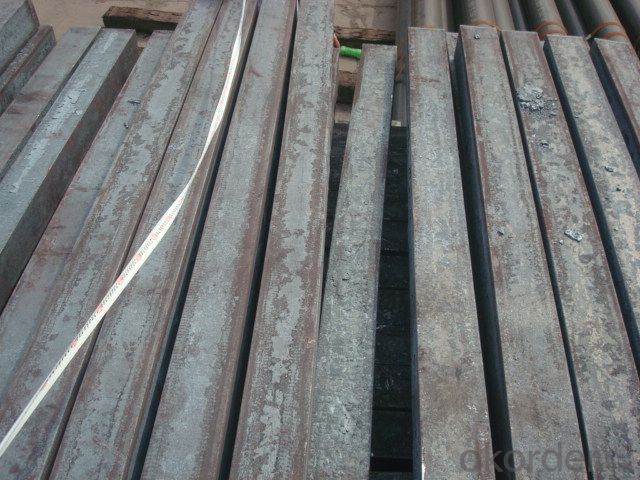
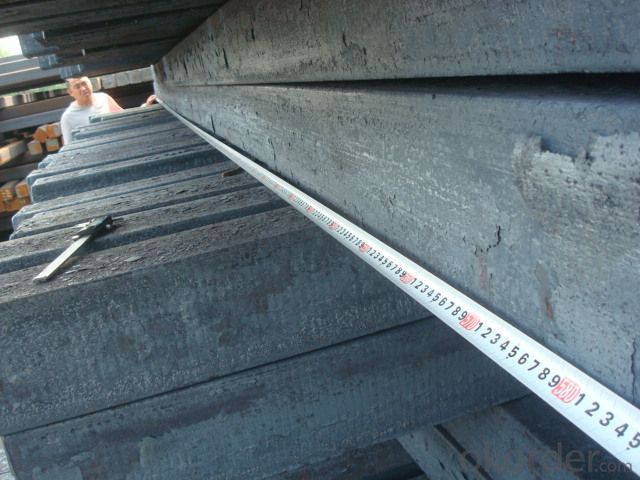
4. Steel Billets/Blooms by Continue Casting Blast FurnaceSpecification
Continue Casting Steel Billet Manufactured By Blasting Furnace rolled steel, after processing can be used for mechanical parts, forging parts, processing all kinds of steel, steel Q345B channel steel, wire rod is the role of the billet. Steel billet is used in the production of semi-finished products, generally cannot be used directly for the society. Steel billets and steel are strictly divided into standard, cannot decide to whether the business enterprise of the final product, and according to unified standards to perform the whole society. Typically, billet and the steel is relatively easy to distinguish, but for some steel billet, and have the same specification and same steel purposes (such as rolling tube billet), whether can be used for other industries, whether through steel processing process, whether through a finished product rolling mill processing to distinguish
Material standard The editor Range of thickness: 150-240 - mm + / - 5 mm width range: 880-1530 - mm + / - 20 mm Length: 3700-10000 - mm + / - 500 - mm Cross-sectional size: 64 * 64; 82 * 82; 98 * 98; 124 * 124; 120 * 150; 152 * 164; 152 * 170 mm Length: 9000 mm Section of tolerance: billet: 1.0 + / - 2.0-1.0 + / - 1.0 mm slab: width: + / - 2.0 mm thickness: + / - 3.0 mm The length tolerance: + / - 200 mm Section diagonal tolerance: 3.5-8.0 MM Billet section size protrusions requirements: < 1242 mm, do not allow; > = 1242 mm, < = 2 mm 1242 mm, < = 3 mm Beheading (shear) extension deformation: < 1242 mm billet: no control; The slab: < = 15 mm Surface tilt: no more than billet section 0.1 Bending: every 1 m length is not more than 10 mm The distortion: length < = 5 m, < = 11. ; The length of the < = 7.5 M, < = 5. Material % 3 sp/PS chemical composition: C Mn Si S P
5.FAQ of Steel Billets/Blooms by Continue Casting Blast Furnace
We have organized several common questions for our clients,may help you sincerely:
①How about your company?
A world class manufacturer & supplier of castings forging in carbon steel and alloy steel,is one of the large-scale professional investment casting production bases in China,consisting of both casting foundry forging and machining factory. Annually more than 8000 tons Precision casting and forging parts are exported to markets in Europe,America and Japan. OEM casting and forging service available according to customer’s requirements.
②How to guarantee the quality of the products?
We have established the international advanced quality management system,every link from raw material to final product we have strict quality test;We resolutely put an end to unqualified products flowing into the market. At the same time, we will provide necessary follow-up service assurance.
③How do you determine the billet section size?
Determination of billet section size in addition to considering the deformation of rolled piece to have enough quantity to meet the finished productThe quality requirements, but also should consider to roll strength and rolling bite into the limitations. The deformation size has a great influence on the product performance.Can make the metal internal organization and deformationPerformance can not meet the quality requirements.Such as high speed steel must have enough deformation,The carbide networkTo be broken or heavy rail and seamlessSteel pipeBy the total elongation coefficient of steel ingot to the finished product usually must alsoGuarantee up to50).
- Q: What are the potential applications of steel billets in the textile aftermarket?
- The textile aftermarket offers a multitude of possibilities for the use of steel billets. One area where they can be applied is in the manufacturing of textile machinery and equipment. Steel billets are versatile enough to produce various components such as gears, shafts, and frames, thanks to their exceptional strength and durability. These qualities enable them to withstand the demanding conditions of textile production. Another potential application of steel billets in the textile aftermarket lies in the production of accessories and hardware. Steel billets can be utilized to create a wide array of essential accessories, including buttons, zippers, and buckles. These accessories play a crucial role in the textile industry and require materials that are both robust and resistant to wear and tear. Furthermore, steel billets can be employed in the fabrication of textile molds and tooling. Textile molds are utilized to create intricate patterns and designs on fabrics, while tooling is necessary for cutting, shaping, and finishing textile products. Steel billets provide the necessary strength and stability required for these applications. Additionally, steel billets can be utilized in the construction of textile warehouses and storage facilities. The high load-bearing capacity of steel makes it an excellent choice for constructing durable and secure storage structures. These warehouses can effectively house textile products, raw materials, and machinery, ensuring their safety and longevity. In conclusion, the potential applications of steel billets in the textile aftermarket are extensive. They can be used in machinery and equipment production, accessories and hardware creation, molds and tooling fabrication, as well as warehouse and storage facility construction. With their strength, durability, and reliability, steel billets are an indispensable material in the textile industry.
- Q: If the casting speed is not steady, what will happen to the billet?
- The instability of the casting speed leads to the unstable surface of the mould and increases the probability of slag entrapment in the mold.
- Q: What are the different types of steel billet packaging materials?
- Some of the different types of steel billet packaging materials include wooden crates, steel drums, plastic wrapping, and cardboard boxes.
- Q: What is the difference between carbon three plants and carbon four plants?
- Also known as C4 plants. Such as corn, sugar cane, sorghum, amaranth and so on.CO2 is the first product of the assimilation of photosynthetic carbon cycle in three carbon compounds 3- phosphoglycerate plants, known as carbon three plants (C3 plants), such as wheat, soybeans, cotton, tobacco, etc.. C3 plants have higher CO2 compensation points than C4 plants, so the survival rate of C3 plants is lower than that of C4 plants when the CO2 content is low.By contrast, the division of C3 plant cells is less definite than that of C4 plants, and CO2 uses less efficiently. To some extent, C3 plants may be considered as prokaryotes in plants, whereas C4 plants are more like eukaryotes".
- Q: What is the role of steel billets in the automotive industry?
- Steel billets are of utmost importance in the automotive industry as they are crucial in the production of various vehicle components and parts. Essentially, steel billets are semi-finished steel products that undergo further processing to achieve the desired shape and size necessary for automotive applications. One primary application of steel billets in the automotive sector is in the production of engine and transmission components. These components, including crankshafts, connecting rods, camshafts, gears, and others that require high strength and durability, rely on steel billets as raw material for forging or casting. This ensures that they can withstand the demanding conditions of engine operation. Another significant use of steel billets in the automotive industry is for the manufacturing of structural components. These components, such as chassis frames, suspension parts, and body panels, need to possess high strength and stiffness to provide safety and rigidity to the vehicle. Steel billets undergo various techniques like hot rolling, cold rolling, or extrusion to produce the necessary forms and shapes required for these structural components. Furthermore, steel billets are also employed in the production of essential fasteners like bolts, nuts, and screws, which are crucial for assembling different parts of the vehicle. These fasteners must possess excellent tensile strength and resistance to vibration and corrosion, making steel billets an ideal choice for their manufacture. Additionally, steel billets find application in the production of various other automotive components, including axles, wheel hubs, brake discs, and steering system parts. All these components require the superior mechanical properties offered by steel billets, such as high strength, toughness, and resistance to wear and tear. In conclusion, steel billets play a vital role in the automotive industry as they serve as raw material for the production of engine and transmission components, structural components, fasteners, and other crucial parts. Their exceptional mechanical properties make them an ideal choice for applications that demand high strength, durability, and reliability, ensuring the safety and performance of vehicles on the road.
- Q: How do steel billets contribute to the water treatment industry?
- The water treatment industry heavily relies on steel billets as they play a crucial role in manufacturing various equipment and structures used in water treatment processes. These billets are primarily used in constructing pipelines, tanks, and other infrastructure required for water treatment plants. One of the most vital applications of steel billets in the water treatment industry is for producing pipe fittings. These fittings connect different sections of pipelines, enabling the smooth transportation of water and other fluids within the treatment facility. Steel billets are commonly used for manufacturing these fittings due to their exceptional strength and durability, ensuring the longevity and reliability of the pipeline system. Furthermore, steel billets are also essential in constructing tanks and vessels used for storing and treating water. These tanks often endure harsh and corrosive conditions, making steel billets the preferred choice due to their corrosion resistance properties. Moreover, steel is a non-porous material, preventing water contamination within the tanks and ensuring the water remains clean and safe to consume. Additionally, steel billets are utilized in fabricating screens and filters used in the water treatment process. These screens and filters play a critical role in removing impurities, sediments, and other contaminants from the water. Steel billets provide the necessary strength and structural integrity to withstand the pressure and flow of water while effectively filtering out unwanted particles. Moreover, steel billets are also used in constructing various structures within water treatment plants, including walkways, platforms, and supports. These structures are vital for providing safe access to equipment and facilitating maintenance and repair activities. Steel billets are favored for such applications due to their high load-bearing capacity and resistance to environmental factors like moisture and chemicals. In conclusion, steel billets are indispensable in the water treatment industry. Their strength, durability, corrosion resistance, and versatility make them the material of choice for constructing pipelines, tanks, fittings, screens, and other structures necessary for efficient and effective water treatment processes.
- Q: Can steel billets be used in high-temperature applications?
- Steel billets can indeed be utilized in applications that involve high temperatures. Generally, these billets are crafted from carbon steel, which possesses commendable heat resistance characteristics. Carbon steel is capable of enduring escalated temperatures without experiencing substantial deformation or strength reduction. Nonetheless, it is crucial to contemplate the particular grade and composition of the steel billets, as dissimilar alloys might have diverse temperature thresholds. Moreover, factors such as the duration of exposure to elevated temperatures, the existence of corrosive surroundings, and the mechanical loading conditions must be considered in order to ascertain the appropriateness of steel billets for high-temperature applications.
- Q: How are steel billets used in the manufacturing of pipes?
- Pipes cannot be manufactured without steel billets, which are indispensable in this process. These semi-finished products made of steel act as the raw material for pipe production. The initial step involves selecting top-notch steel and melting it in a furnace to form molten steel alloy. After the steel has melted, it is poured into molds of specific sizes and shapes to create billets. These billets then undergo a cooling and solidification process. By solidifying, the steel achieves the desired structural properties, including strength and durability. Once the steel billets have cooled down, they undergo further processing to become seamless or welded pipes. In the case of seamless pipes, the billets are heated and pierced to form a hollow tube-like structure. These pierced billets are then elongated and stretched to achieve the desired diameter and thickness of the pipe. This technique, known as hot-rolling, results in seamless pipes with consistent dimensions and improved mechanical properties. On the other hand, welded pipes are manufactured using different methods. One common method is the electric resistance welding (ERW) process. It involves heating the billets and passing them through a series of rollers to shape them into a cylindrical form. The edges of the billets are then fused together using an electric current, creating a continuous weld. Other welding techniques, such as submerged arc welding (SAW) and high-frequency induction welding (HFIW), can also be employed to manufacture welded pipes from steel billets. In both seamless and welded pipe manufacturing, the quality of the steel billets is of utmost importance. It directly impacts the integrity and performance of the final product. The appropriate selection of steel grades and strict adherence to manufacturing standards are vital to produce pipes that can withstand high pressure, extreme temperatures, and corrosive environments. To sum up, steel billets are essential in the pipe manufacturing process. They act as the starting material for pipes, whether through the hot-rolling technique for seamless pipes or various welding methods for welded pipes. Utilizing high-quality steel billets and employing precise manufacturing processes allow for the production of pipes with the necessary strength, durability, and dimensional accuracy required for a wide range of industrial and commercial applications.
- Q: How are steel billets tested for quality?
- Steel billets are tested for quality through a series of rigorous procedures to ensure that they meet the required standards and specifications. These tests are crucial as they help determine the strength, composition, and other mechanical properties of the billets. One common method used to test steel billets is the ultrasonic testing (UT). This technique involves the use of high-frequency sound waves that are transmitted through the billet. The waves are then reflected back and detected by a receiver, which allows for the identification of any internal defects or inconsistencies in the material. Another important test is the hardness testing. This involves measuring the hardness of the billet's surface using various methods such as the Brinell, Rockwell, or Vickers hardness test. This helps assess the billet's resistance to indentation and provides an indication of its strength and durability. Chemical composition analysis is also crucial in determining the quality of steel billets. This is done by taking samples from the billet and subjecting them to a chemical analysis. By measuring the concentrations of different elements present in the steel, such as carbon, sulfur, and manganese, it is possible to verify if the billet meets the required composition standards. In addition, physical tests such as tensile testing are conducted to determine the mechanical properties of the steel billets. Tensile tests involve applying a controlled amount of force to the billet and measuring the resulting deformation or elongation. This helps assess the billet's strength, ductility, and other mechanical properties. Furthermore, visual inspection is an essential part of quality testing. Qualified inspectors carefully examine the billets for any surface defects, cracks, or irregularities that could affect their quality or performance. Overall, steel billets undergo a comprehensive range of testing procedures, including ultrasonic testing, hardness testing, chemical composition analysis, and physical tests, to ensure that they meet the required quality standards. These tests are crucial in verifying the strength, composition, and overall quality of the billets before they are used in various industrial applications.
- Q: What is billet?
- Mould blank and continuous casting billet: mould blank and continuous casting billet,
Send your message to us
Steel Billets/Blooms by Continue Casting Blast Furnace
- Loading Port:
- Tianjin
- Payment Terms:
- TT OR LC
- Min Order Qty:
- 1000 m.t.
- Supply Capability:
- 10000 m.t./month
OKorder Service Pledge
OKorder Financial Service
Similar products
Hot products
Hot Searches
Related keywords
